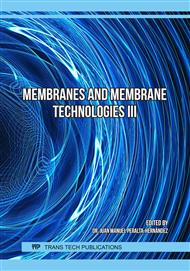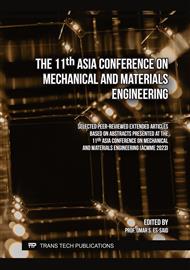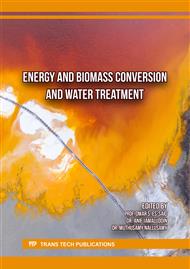p.105
p.111
p.119
p.129
p.135
p.145
p.153
p.159
p.177
Fabrication of Graphene-Modified Polyvinylidene Fluoride-co-Hexafluoropropylene Porous Polymeric Flat Sheet Membranes
Abstract:
We report the fabrication of porous hydrophobic flat sheet membranes composed of polyvinylidene fluoride-co-hexafluoropropylene (PVDF-co-HFP), which is incorporated with graphene (GNP) concentrations of (0.2, 0.5, and 0.8 wt.%) as the hydrophobic filler. FTIR, XRD, and SEM results were used to analyze the composites' functional groups, crystallinity and surface morphology. The water contact angles were 116 ±1.2°; 120 ±0.9°; 126 ±0.7°; 130 ±0.6° for pristine, 0.2 wt%, 0.5 wt%, and 0.8 wt% of GNP membranes, respectively. Moreover, the graphene incorporation enhanced the fabricated polymer's ultimate tensile strength (UTS). The UTS was as follows 2.4±0.01, 5.43±0.02, 7.485±0.015 and 6±0.01MPa for pristine, 0.2 wt% GNP, 0.5 wt% GNP and 0.8 wt% GNP respectively. The highest UTS was (7.485 ±0.015 MPa) for the 0.5 wt% GNP. Graphene incorporation (0.5 wt%) enhanced the membranes’ porosity (78 ±1.9%). This study explored the effect of graphene to improve the flat sheet membranes' mechanical strength, hydrophobicity, and porosity, which can then be applied in desalination using membrane distillation to mitigate clean water shortages and crises.
Info:
Periodical:
Pages:
153-158
Citation:
Online since:
December 2023
Keywords:
Price:
Сopyright:
© 2023 Trans Tech Publications Ltd. All Rights Reserved
Share:
Citation:





